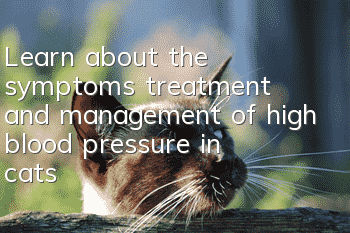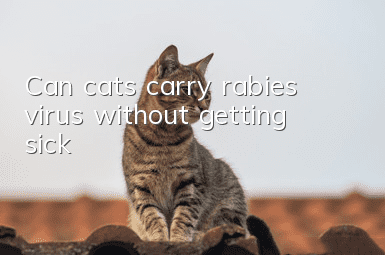Learn about the symptoms, treatment and management of high blood pressure in cats!

Obesity can cause high blood pressure
Let’s learn about the symptoms, treatment and management of high blood pressure in cats! Any animal needs to maintain normal blood pressure during normal metabolic activities of the body. Too high or too low blood pressure will cause There are many reasons for damage to the body and abnormal blood pressure. Generally speaking, cardiovascular disease is the most important factor. For cats, high blood pressure is more common in older cats. Therefore, in recent years, the monitoring and management of high blood pressure have also improved. Become a regular item.
Although there is no recommendation that blood pressure should be measured comprehensively in all animals, blood pressure measurement is very important in animals that have clinical symptoms, such as blindness, ataxia, epilepsy, etc. caused by hypertension. Hemorrhage in the anterior chamber of the eye or sudden syncope (may be related to cerebrovascular hemorrhage, edema or stroke). In addition, diseases other than heart disease can also cause symptoms of hypertension, such as azotemic kidney disease, hyperthyroxinemia, hyperadrenaline, pheochromocytoma, adrenocorticosterone-secreting tumors, and obvious obesity.
1. Causes and pathology of hypertension
The determinants of blood pressure are cardiac output (heart rate and stroke volume) and peripheral vascular resistance. Systemic arterial blood pressure is regulated by a complex mechanism. Baroreceptors in the carotid sinus and aortic arch respond to changes in blood pressure; lowering blood pressure stimulates sympathetic nerve release, causing vasoconstriction, increased cardiac contractility, and increased heart rate to normalize blood pressure; regulation The hormones involved in blood pressure include catecholamines, vasopressin, renin, angiotensin, aldosterone, prostaglandins and atrial natriuretic peptide. The renin-angiotensin-aldosterone system may be the most important part.
Due to the above regulatory mechanisms, enhanced sympathetic nerve activity, increased catecholamine production, activation of the angiotensin-aldosterone system accompanied by secondary water and salt retention vasoconstriction, etc., can lead to chronic elevation of blood pressure.
Hypertension can be divided into primary or secondary. The cause of primary hypertension is not fully understood, but some cases may be related to genetic factors. One study reported that 2% of healthy cats had essential hypertension. Clinically, the vast majority of hypertension cases are secondary to other diseases. Renal diseases, hyperadrenocortical function, and hyperthyroidism are common diseases that cause elevated blood pressure. Hypertension in dogs and cats with chronic renal failure can be caused by a variety of mechanisms: low glomerular filtration rate and reduced sodium secretion can increase blood volume; local renal ischemia or reduced renal blood flow can activate angiotensin- The aldosterone system reduces the production of vasodilator substances (such as prostaglandins, kallikrein) and related effects in secondary hyperparathyroidism.
2. Clinical symptoms of high blood pressure
1. Eye symptoms
Severe high blood pressure can cause eye problems Injury, the most easily detectable symptom is eyeball bleeding in the retina or vitreous body or even the anterior chamber of the eye, followed by retinal detachment or atrophy, retinal detachment, and retinal detachment.Edema, retinal vasculitis, retinal vessel tortuosity, and eventually increased intraocular pressure may lead to glaucoma. Clinical symptoms of sudden blindness may occur due to retinal detachment or hemorrhage.
2. Neurological symptoms
Clinical symptoms caused by poor control of high blood pressure usually have a poor prognosis. The most common cause is the occurrence of blood clots in the brain. . Severely hypertensive cats (systolic blood pressure > 300 mmHg) will develop progressive confusion, nodding, or epileptic syndrome. This syndrome is caused by brain edema. The reason is that once the systemic arterial pressure exceeds the self-regulatory range, Excessive intracapillary hydrostatic pressure will result in brain edema.
3. Kidney symptoms
Systolic blood pressure continues to rise above 160 mmHg. Such blood pressure will cause progressive kidney damage in dogs, and the severity of kidney damage will be related to the blood pressure. The degree of increase is positively correlated. The main cause of pathological damage to the kidney is that high blood pressure will cause a decrease in renal perfusion, resulting in changes in the glomerulus and interstitial tubules such as ischemia, necrosis, and atrophy, which will worsen proteinuria. These gradual changes are difficult to quantify in animals, but when blood pressure is already above 160 mmHg they increase the likelihood of uremia and mortality in animals with chronic kidney disease. Similarly in cats, systolic blood pressure higher than 160 mmHg is also a factor causing progressive kidney damage.
4. Heart symptoms
Heart murmurs or galloping rhythms may occur. Systemic hypertension secondary to congestive heart failure is rare. Most cases The cause is caused by left ventricular hypertrophy, diastolic dysfunction, or the early stages of valvular insufficiency.
3. Treatment of hypertension
1. Drug treatment
The drug commonly used in drug treatment is angiotensin-converting enzyme Inhibitors (ACEI), calcium channel blockers and beta-blockers.
ACEI drugs (such as enalapril, benazepril) reduce peripheral vascular resistance and volume retention by blocking the conversion of angiotensin I to angiotensin II. ACEIs reduce proteinuria and slow the progression of kidney disease. Helps resist kidney damage caused by high blood pressure, but ACEI is usually ineffective in treating high blood pressure in cats with severe kidney failure.
The function of calcium channel blockers is to dilate blood vessels and reduce peripheral vascular resistance; some can also reduce cardiac output through negative chronotropic and inotropic effects. Amlodipine is the preferred stress-reducing drug for cats, and its antihypertensive effect lasts at least 24 hours. In addition, if amlodipine alone is not fully effective in affected cats, beta-adrenergic blockers or ACEI can be used in combination. Amlodipine is more effective in dogs, so the initial dosage should be low and can be increased later as appropriate.
Beta-blockers can lower blood pressure by reducing heart rate, cardiac output, and renal renin release. Atenolol and propranolol are the most commonly used. Recommended treatments for feline thyroid functionThe drugs that cause high blood pressure are beta-blockers, but beta-blockers alone are usually ineffective in treating high blood pressure in cats with kidney disease.
Alpha1-adrenergic blockers reduce peripheral vascular resistance by antagonizing the vasoconstrictive effects of adrenergic receptors and are effective in the treatment of hypertension caused by pheochromocytoma.
For animals with acute increase in blood pressure, direct vasodilator drugs, such as hydralazine, nitroprusside, and acepromazine, can be used. These drugs are suitable for acute retinal detachment and hemorrhage, encephalopathy, or intracranial hemorrhage. , animals with acute renal failure and acute heart failure. Use of these medications requires adequate monitoring to prevent hypotension.
To evaluate the effect of antihypertensive treatment, blood pressure should be monitored every 1-2 weeks during initial administration. When blood pressure is effectively controlled, monitoring should be performed every 2-3 months. Some animals that initially respond to medication may later fail to respond to the same treatment.
Adjunctive treatment to limit salt intake is an important management in conjunction with the treatment of hypertension. For patients with severe renal failure, kidney prescription food is a good choice. Obese animals should also undergo weight loss.
2. Dietary treatment
Although there are not many studies, a low-sodium diet will provide less than 0.25% sodium on a dry weight basis. Dietary sodium restriction will be the most effective. The first step of selection is if the hypertension is mild (<170-100mmHg) and no target organ damage occurs. In animals with chronic kidney disease and hypertension, it is more important to maintain adequate caloric intake than to continue feeding a low-sodium diet. Therefore medical therapy needs to be established first, and when blood pressure has stabilized the animal may be able to be switched to a low-sodium diet.
- Advantages and Disadvantages of Bathing Cats
- The cat keeps meowing
- Is it useful to take probiotics for cats with vomiting?
- How to take care of a female cat that has just given birth
- What are the signs that a teacup cat is pregnant?
- Which is better, a male cat or a female cat? Is it better, a male cat or a female cat?
- How to take care of a cat after giving birth?
- Common internal parasites in cats and their prevention and treatment methods, you must know about them as a cat owner
- Do Siamese cats have good personalities?
- Why do cats get angry?



